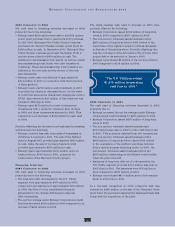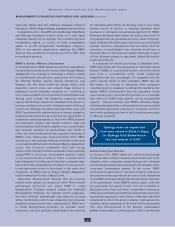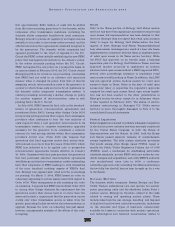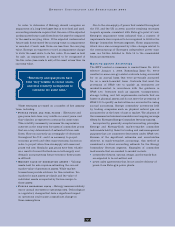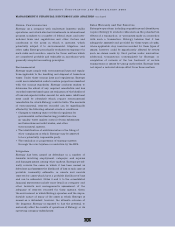Entergy 2003 Annual Report Download - page 44
Download and view the complete annual report
Please find page 44 of the 2003 Entergy annual report below. You can navigate through the pages in the report by either clicking on the pages listed below, or by using the keyword search tool below to find specific information within the annual report.
42
ENTERGY CORPORATION AND SUBSIDIARIES 2003
MANAGEMENT’S FINANCIAL DISCUSSION AND ANALYSIS
continued
decommissioning nuclear plants at the end of their licensed
lives, including the sufficiency of funds in decommissioning
trusts. In the event of an unanticipated early shutdown of
any of Entergy’s nuclear plants, Entergy may be required
to provide additional funds or credit support to satisfy
regulatory requirements for decommissioning.
Concerns are being expressed in public forums about
the safety of nuclear generating units and nuclear fuel, in
particular in the area where Entergy’s Indian Point units
are located, which are discussed in more detail below. These
concerns have led to various proposals to federal regulators
as well as governing bodies in some localities where
Entergy owns nuclear plants for legislative and regulatory
changes that could lead to the shut-down of nuclear units,
denial of license extension applications, municipalization of
nuclear units, restrictions on nuclear units as a result of
unavailability of sites for nuclear fuel disposal, or other
adverse effects on owning and operating nuclear power
plants. Entergy believes that its generating units are in
compliance with NRC requirements and intends to vigor-
ously respond to these concerns and proposals.
Groups of concerned citizens and local public officials
have raised concerns about safety issues associated with
Entergy’s Indian Point power plants located in New York.
They argue that Indian Point’s security measures and
emergency plans do not provide reasonable assurance to
protect the public health and safety. The NRC has original
jurisdiction over these matters. In a decision that became
final on December 13, 2002, the NRC denied a petition filed
by Riverkeeper, Inc. asking the NRC to order Entergy to
suspend operations, revoke the operating license, or adopt
other measures, including a temporary shutdown of Indian
Point 2 and Indian Point 3. The NRC noted that after
September 11, 2001, it ordered enhanced security measures
at all nuclear facilities and found that as a result of the
collective measures taken since September 11, 2001, the
security at Indian Point provides adequate protection of
public health and safety. The NRC further found that the
existing emergency response plans are flexible enough to
respond to a wide variety of adverse conditions, including a
terrorist attack, and that the current spent fuel storage
system adequately protects the public health and safety.
Riverkeeper petitioned the United States Court of Appeals
for the Second Circuit for review of this final action of the
NRC, and, in February 2004, the Second Circuit affirmed
the NRC and dismissed the petition for review.
In addition, certain concerns are being raised regarding
the adequacy of the emergency evacuation plans for Indian
Point. These matters initially must be reviewed by the
Federal Emergency Management Agency (FEMA).
Jurisdiction as to the overall adequacy of emergency
planning and preparedness for Indian Point lies with the
NRC. Entergy believes that the emergency evacuation plans
for Indian Point are adequate to ensure the public health
and safety in compliance with NRC requirements. Entergy
is working with New York state and county officials,
FEMA, the NRC, and other federal agencies to make addi-
tional improvements to the plans that may be warranted
and to assure them as to the adequacy of the plans.
In July 2003, FEMA issued its notice of certification of the
Indian Point Emergency Plan. The NRC followed soon there-
after with its endorsement. In August 2003, Westchester
County filed an administrative appeal of the FEMA ruling
that the emergency plans are adequate to protect the public
health and safety. FEMA regulations on emergency plans
provide for appeals in only two situations: (1) FEMA’s
approval or disapproval of a radiological emergency
response plan (RERP) for a nuclear power facility; and
(2) FEMA’s determination to withdraw approval for a state
or local RERP. In both cases, the appeal process is the same.
LITIGATION
Entergy and its subsidiaries are involved in the ordinary
course of business in a substantial amount of employment,
asbestos, hazardous material, and other environmental and
rate-related proceedings and litigation. Entergy uses legal
and appropriate means to contest vigorously litigation
threatened or filed against it, but litigation poses a significant
business risk to Entergy.
CRITICAL ACCOUNTING ESTIMATES
The preparation of Entergy’s financial statements in
conformity with generally accepted accounting principles
(GAAP) requires management to make estimates and
judgments that can have a significant effect on reported
financial position, results of operations, and cash flows.
Management has identified the following estimates as
critical accounting estimates because they are based on
assumptions and measurements that involve an unusual
degree of uncertainty, and there is the potential that
different assumptions and measurements could produce
estimates that are significantly different than those recorded
in Entergy’s financial statements.
NUCLEAR DECOMMISSIONING COSTS
Entergy owns a significant number of nuclear generation
facilities in both its U.S. Utility and Non-Utility Nuclear
business units. Regulations require that these facilities be
decommissioned after the facility is taken out of service,
and funds are collected and deposited in trust funds during
the facilities’ operating lives in order to provide for this
obligation. Entergy conducts periodic decommissioning
cost studies (typically updated every three to five years) to
estimate the costs that will be incurred to decommission the
facilities. Note 9 to the consolidated financial statements
contains details regarding Entergy’s most recent studies
and the obligations recorded by Entergy related to decom-
missioning. The following key assumptions have a signifi-
cant effect on these estimates:



